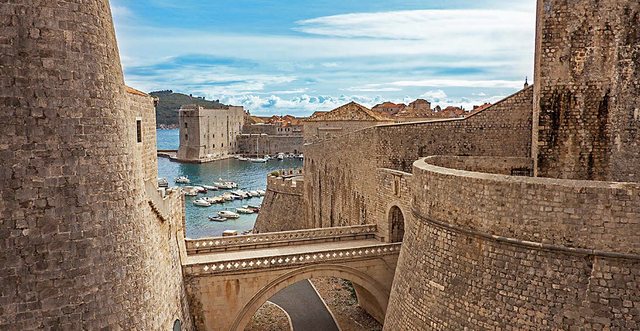
The impregnable walls of Dubrovnik


Situated along the rugged Adriatic coast, the walled city of Dubrovnik in Croatia has long been a cultural and economic hub in the region. Yet this picturesque city has experienced many conflicts and wars throughout its history.
The current walls of Dubrovnik date mainly from the 14th century, but their origins are much older. It is believed that the construction of the first limestone fortifications around the city began in the Early Middle Ages at the end of the 8th century. From that point on, the Walls of Dubrovnik were repeatedly added to and rebuilt over time as new threats arose.
In the 9th and 10th centuries, walls were built to protect the eastern part of the city. When the Saracens (an Arab people) attacked the city in the 9th century, the siege lasted 15 months, indicating that even at this early period the city was well-fortified.
In the 12th century, the sea channel that separated the city from the mainland was filled with earth, and the city was merged with other settlements inland. This led to the addition of the original walls, forming a single wall around the entire area.
These relatively simple walls were continually expanded and reinforced as Dubrovnik began to become more important as a trading center and naval power in the region. Most of the construction took place between the 14th and 15th centuries, spurred by the city gaining full independence from the Venetians.
During this time, the walls were expanded to surround the entire city, while various towers and forts were added. The walls were also greatly reinforced, becoming thicker. They survived the earthquake of 1667 intact, but also many sieges by Ottoman armies in the 16th-17th centuries.
During these sieges, a kind of slope was added to the outer walls, designed to deflect enemy cannon fire. In fact, the walls remained largely intact until the Croatian War of Independence in the 1990s, when the Serbs heavily bombarded the city. The walls suffered extensive damage, but have since been restored. The walls cover an impressive area. They are 1,940 meters long and up to 25 meters high. Their thickness varies, but is usually somewhere between 4-6 meters. They were built mainly with local limestone and by local stonemasons.
In addition to the walls themselves, the city's defensive structure features several fortresses built within the walls themselves. After Constantinople (present-day Istanbul) fell to the Ottomans in 1453, the people of Dubrovnik (or Ragusa as it was then known) needed more defensive structures.
After the fall of Bosnia in 1463, the locals invited the famous Florentine architect Micheloco di Bartolomeo to lead the work on fortifying the defensive walls.
The Ottomans attacked Dubrovnik several times throughout history.
The largest of these occurred in 1537, with a siege lasting several months, accompanied by repeated attacks. In the end, the Ottomans withdrew and Dubrovnik managed to maintain its independence from Ottoman rule for several more centuries.
But even victories come to an end. In 1806, a Russian fleet arrived in Dubrovnik, requesting use of the port for repairs and supplies. At the time, the Russians were at war with the French, and fearing French retaliation, Dubrovnik refused.
In response, the Russians launched a siege and bombarded the city walls with over 3,000 cannonballs, causing extensive damage to the city. Eventually, some troops managed to enter the city, looting its wealth. The citizens turned to the French for help, who quickly ended the Russian siege and the city was saved.
The French army, led by Napoleon Bonaparte himself, entered the city in 1806. But salvation from the French was a double-edged sword. Because in 1808, Marshal August De Marmo abolished the Republic of Ragusa, and made it part of the Illyrian provinces of the French Empire, declaring himself the "Duke of Ragusa".
Then in 1814, the city was besieged and bombarded by Austrian and English troops, until the French who ruled it surrendered. The most recent assault on the Walls of Dubrovnik occurred during the Croatian War of Independence. The siege began in October 1991, when the Yugoslav People's Army (JNA) launched a massive attack on Dubrovnik.
With the help of Serbian paramilitary forces, the JNA hoped to capture the city and take control of a strategically important region of Dalmatia. But the defenders (mainly Croatian soldiers and local volunteers) put up a fierce resistance, but were outnumbered and poorly armed.
The siege lasted several months, and the city walls experienced heavy bombing and shelling. Many of the city's historic buildings, such as the old town, were severely damaged or completely destroyed. Many civilians were killed or injured. But a Croatian counterattack ended the siege in mid-1992./ bota.al

Scandal erupts: Poll against SPAK intercepted!
ideas

Don't make fun of Berisha's old age, but of his dream of becoming a groom again.


We will finally vote!
top
Alfa recipes
TRENDING 
services
- POLICE129
- STREET POLICE126
- AMBULANCE112
- FIREFIGHTER128



























